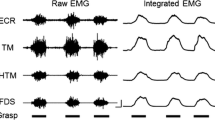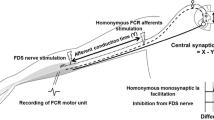Summary
The H reflex of flexor carpi radialis and radial-induced reciprocal inhibition were recorded in normal subjects during conditioning stimulation of the contralateral median or radial nerves. It was found that stimulation of the contralateral median nerve enhanced the degree of reciprocal inhibition exerted by the radial nerve on the median nerve, while contralateral radial nerve stimulation reduced the reciprocal inhibition exerted by the extensor on the flexor. In two subjects in which a pure extensor H reflex was recorded specular features were observed following contralateral median and radial stimulation. These findings are considered to be the electrophysiological manifestation of contralateral modulation of reciprocal inhibition, which is likely to act at the level of the IA interneurone.
Similar content being viewed by others
References
Andersson O, Forssberg H, Grillner S, Lindquist M (1978) Phasic gain control of the transmission in cutaneous reflex pathways to motoneurones during “fictive” locomotion. Brain Res 149: 503–507
Baldissera F, Cavallari P, Fournier E, Pierrot-Deseilligny E, Shindo M (1987) Evidence for mutual inhibition of opposite IA interneurones in the human upper limb. Exp Brain Res 66: 106–114
Baldissera F, Hultborn H, Illert M (1981) Integration in spinal neuronal systems. In: Brooks VB (ed) Handbook of physiology, sect I. The nervous system, vol II. Motor control. Am Physiol Soc, Bethesda MD, pp 509–595
Bras H, Cavallari P, Jankowska E, Kubin L (1989) Morphology of midlumbar interneurones relaying information from group II muscles afferents in the cat spinal cord. J Comp Neurol 290: 1–15
Cavallari P, Fournier E, Katz R, Pierrot-Deseilligny E, Shindo M (1984) Changes in reciprocal IA inhibition from wrist extensors to wrist flexors during voluntary movement in man. Exp Brain Res 56: 574–576
Day BL, Rothwell JC, Marsden CD (1983) Transmission in the spinal reciprocal IA inhibitory pathway preceding willed movements of the human wrist. Neurosci Lett 37: 245–250
Day BL, Marsden CD, Obeso JA, Rothwell JC (1984) Reciprocal inhibition between the muscles of the human forearm. J Physiol 349: 519–534
Dietz V, Horstmann A, Berger W (1989) Interlimb coordination of leg muscles activation during perturbation of stance in humans. J Neurophysiol 62: 680–693
Duysens J, Pearson KG (1976) The role of cutaneous afferents from the distal hindlimb in the regulation of the step cycle of thalamic cats. Exp Brain Res 24: 245–255
Duysens J, Stein RB (1978) Reflexes induced by nerve stimulation in walking cats with implanted cuff electrodes. Exp Brain Res 32: 213–224
Eccles JC (1969) The inhibitory pathway of the central nervous system. Liverpool University Press, Liverpool
Forssberg H (1979) Stumbling corrective reaction: a phase-dependent compensatory reaction during locomotion. J Neurophysiol 42: 936–953
Hultborn H (1976) Transmission in the pathway of reciprocal IA inhibition to motoneurones and its control during the tonic stretch reflex. In: Homma S (ed) Understanding the stretch reflex. Elsevier, Amsterdam, pp 235–255 (Prog Brain Res, vol 44)
Hultborn H, Illert M, Santini M (1976 a) Convergence on interneurones mediating the reciprocal IA inhibition of motoneurones. I. Disynaptic IA inhibition of IA inhibitory interneurones. Acta Physiol Scand 90: 193–201
Hultborn H, Illert M, Santini M (1976 b) Convergence on interneurones mediating the reciprocal IA inhibition of motoneurones. II. Effects from segmental flexor reflex pathways. Acta Physiol Scand 96: 351–367
Lundberg A (1970) The excitatory control of the IA inhibitory pathway. In: Anderson P, Jansen JKS (eds) Excitatory synaptic mechanisms. Universitetsforlaget, Oslo, pp 333–340
Sabatino M, Pepin JL, La Grutta V, Delwaide PJ (1987) Reciprocal inhibition during arm movement in man. Electroencephalogr Clin Neurophysiol 66: 125–126
Sabatino M, Ferraro G, Caravaglios G, Sardo P, Delwaide PJ, La Grutta V (1992) Evidence of a contralateral motor influence on reciprocal inhibition in man. J Neural Transm [PD-Sect] 4: 257–266
Yang FJ, Stein RB (1990) Phase-dependent reflex reversal in human leg muscles during walking. J Neurophysiol 63: 1109–1117
Author information
Authors and Affiliations
Rights and permissions
About this article
Cite this article
Sabatino, M., Sardo, P., Ferraro, G. et al. Bilateral reciprocal organisation in man: focus on IA interneurone. J. Neural Transmission 96, 31–39 (1994). https://doi.org/10.1007/BF01277926
Received:
Accepted:
Issue Date:
DOI: https://doi.org/10.1007/BF01277926




